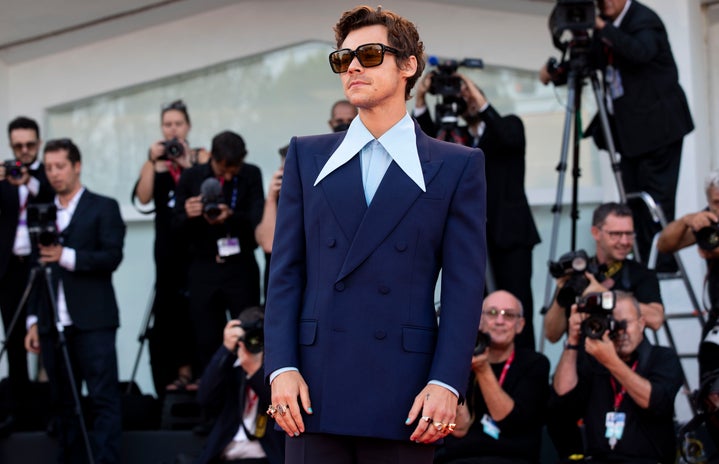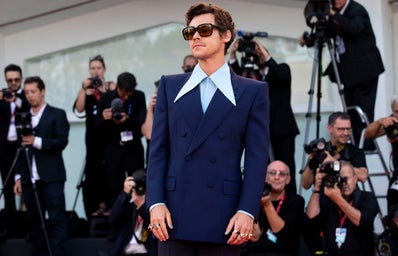It is no secret that I have become obsessed with male fashion, so when I saw that the Victoria and Albert Museum was putting on an exhibition titled ‘Fashioning Masculinities: The Art of Menswear’, I was both excited and curious to see how they would present this vast and complex topic.
Today, the discussion surrounding toxic masculinity has become ever-present especially among Gen-Z who are trying to push rigid gender binaries through artistic mediums. Throughout the centuries, male fashion has become an imposition, pressuring men to conform to a certain kind of dress to escape the risk of being mislabelled. Ironically, it has become a tool for oppression rather than a mode of self-expression and individuality.
In collaboration with Gucci, the exhibition at the V&A has attempted to put the pieces together, exploring the evolution of male dress from as early as the 16th century until present day, whilst also challenging key problematics with toxic masculinity. Gucci’s Creative Director, Alessandro Michele, is trying to push the brand away from fashion categories specifically allocated to the male or female body, in the hopes that by blurring the lines between trends and styles, fashion can become more inclusive.
The exhibition layout was clear and chronological, comprising 100 outfits and 100 artworks from the extensive V&A Collection. The first room named ‘Undressed’ strips back male fashion to the very basics: the male body and undergarments. I was surrounded by examples of contrasting mix-media: on my left an ancient cast from a Greek sculpture of Apollo and on my right, video montages of plus-size naked male models dancing in slow-motion. The message is loud and clear: the male body has always been misrepresented. This is exemplified by the extra muscles, that were anatomically non-existent, added in Greek sculpture for the mere purpose of idealised proportions. One could say that this was the genesis of what we now call Facetune and cosmetic surgery.
At the end of my tour, I got to the part I had most been waiting for; the final room ‘Dressed’, showcased all the ‘bling-tastic’ outfits that had invaded my TikTok, worn by today’s male fashion icons. These lavish gowns, worn by the likes of Billy Porter and Bimini Bon Boulash actively challenge the gender norms that have been ingrained into Western societies.
The fascination young girls have for Timothée Chalamet and Harry Styles can easily be explained: they are examples of cis-gender men who are not afraid to step outside the boundaries that society has imposed on them ‘non-masculine’ clothing, without worrying about how this will change the public’s perception of them. My personal favourite is Harry Styles’ look from the SIRIUSXM Performance in February 2020, when he rocked what seems to be a modern take on the ‘Grandad V-neck sweater’, paired with infamous masculine pin-striped suit trousers. By throwing in a yellow polka-dotted print and a high-waisted cut to the trousers, Harry has subverted masculinity by wearing a structured look that has been softened with feminine touches.
One cannot talk about male fashion without giving credit to the greatest voice behind this Anti-Toxic Masculinity movement, Grayson Perry. The manifesto he sets up in his book, The Descent of Man, redefines what it means to be a man today; men should not feel the pressure to behave ‘macho’ to be deemed as manly. As an artist he explores this idea through art and fashion, notably culminated in ‘Claire’s Coming Out Dress’, a statement piece which he describes to be “the crack cocaine of femininity”.[1] By wearing excessively vibrant and hyperfeminine frocks, Perry proves that a straight man can also experiment with transvestism, thus undermining the traditions and stereotypes that perpetuate gender identity.
The critique I may offer to the exhibition would be that it focused only on Eurocentric ideas of male dress. Fashion outside of Europe has also played an enormous role and its representation would have enriched the exhibition even more, as it has inspired so many aspects of fashion from pattern to form and textures thus, deserves to be recognised and commended.
Overall, I saw this exhibition as a mighty catalyst to push the conversations surrounding the male image and toxic masculinity even further, through the lens of fashion. We also owe a lot of the progress made in the fashion world, to the on-going conversations present in the LGBTQ+ community, about gender and sexuality spectrums, that are having an enormous impact on inclusivity and flexibility in self-expression. I hope that these voices in society will continue to grow louder and that we may reach a point where the future of fashion will become authentically genderless.
Original photos by Cecilia Blotto
[1] Sidonie Wilson, ‘Grayson Perry, Britain’s Dress-up Doll – Fashion Unfiltered’. 2 September 2019. https://fashionunfiltered.com/culture/2019/grayson-perry-britains-dress-up-doll/.


